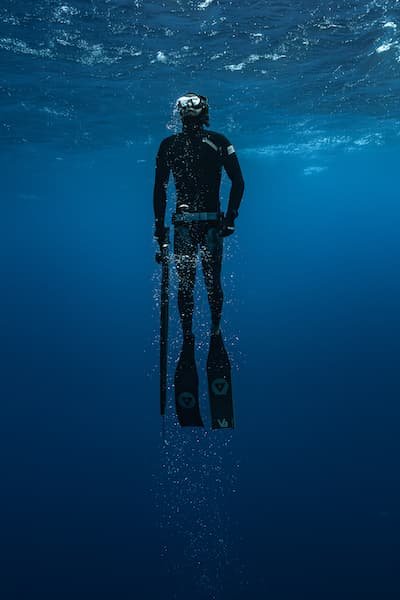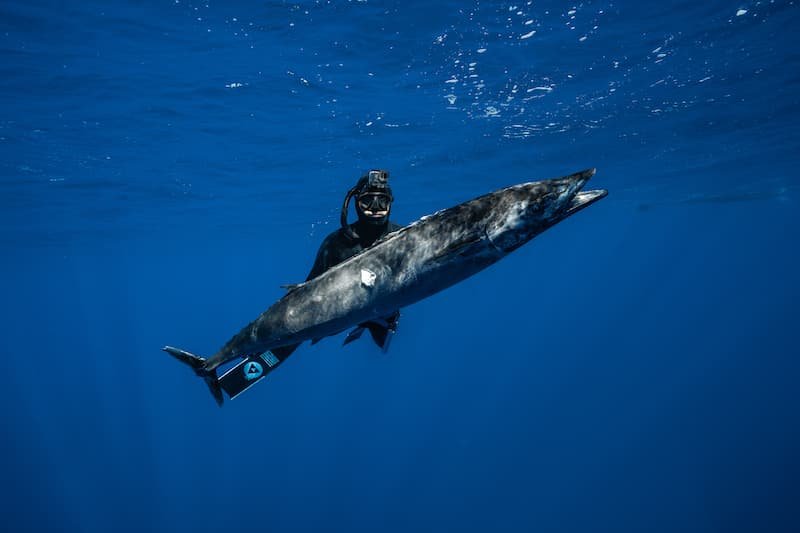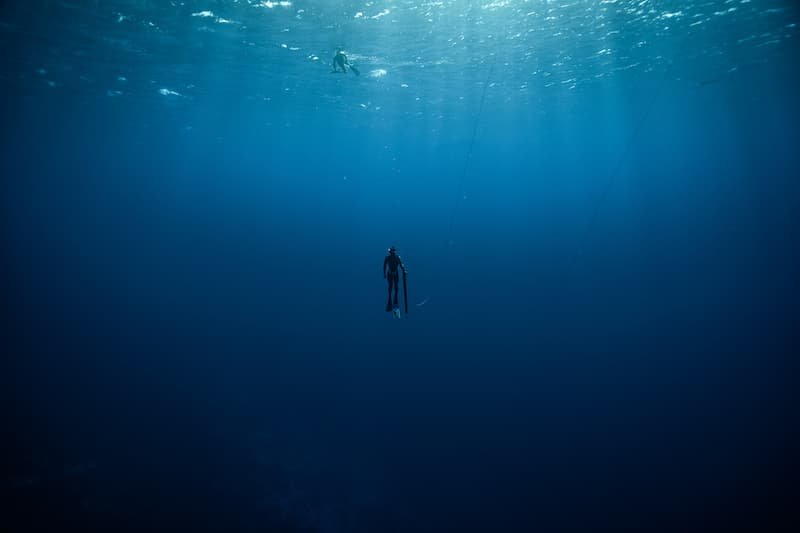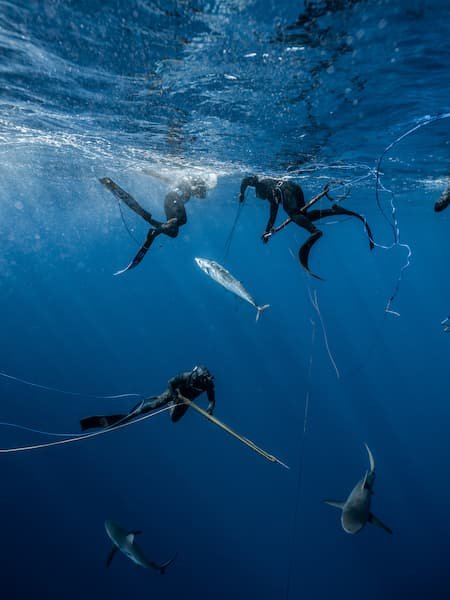In the world of spearfishing, catchphrases are prevalent and have become commonplace. Often, people tend to overlook them, such as "one up, one down" or the recommendation of two to three times your dive time for your surface interval. While these are fundamental principles and make perfect sense, I want to delve into some more obscure aspects that people might not usually consider.
After spearfishing with various partners in multiple locations around the world, it becomes evident that newer or less safety-conscious divers, who may not have taken safety or freediving classes, often overlook crucial aspects. This lack of concern can make divers who prioritize safety and have undergone proper training uncomfortable. The desire is for both personal protection and the safety of others.
One of the most significant concerns among my dive partners and fellow Team Alchemy members regarding safety in spearfishing revolves around the principle of "one up, one down." This concept dictates that if one person is on the surface, the other should be below. The person on the surface should not leave until the other diver resurfaces, ensuring a proper dive execution and safety confirmation.
However, I've observed that some dive partners, while adhering to the safety precaution, maintain a distance that is beyond what my consistent dive partners and I find comfortable. Although they wait at the surface before their dive until the other diver is safely up, they are positioned farther away than our preferred proximity. For us, it is crucial to be less than an arm's length away, as being further might pose a risk.
This emphasis on closeness is significant because, in critical situations like a loss of motor control (LMC) approaching blackout, a diver positioned 15 feet away may not reach me in time for a swift and effective response. By the time they swim over, I could already be descending, increasing the risk associated with delayed safety measures.

Another significant practice that my spearfishing partners and I consistently adhere to is meeting at -10 meters. Often, we find ourselves diving in depths of around 35 meters, navigating rocky terrain on the ocean floor. Particularly in Hawaii, such as here in Maui, reaching significant depths is necessary before encountering fish, often around 30 meters or so. Fortunately, the visibility here is exceptional, ranging from 25 to 30 meters throughout the year, enabling us to keep a close eye on each other's whereabouts.
In most instances, I maintain constant visual contact with my partner and stay aware of the ongoing situation. When I hear the sound of the gun firing or notice that my partner has taken a shot at a fish or another target, my standard practice is to meet them at 10 meters. Upon hearing the shot, I wait for them to start ascending, and I join them at 10 meters, cruising to the surface together to ensure their well-being.
This practice goes beyond the typical "one up, one down" or staying within arms' length. The decision to meet at -10 meters is rooted in the understanding that the challenges a diver faces after taking a shot can vary significantly. They may have encountered difficulties such as the fish getting entangled or a gun malfunction. By meeting them at -10 meters, I aim to provide immediate assistance, acknowledging that their experience underwater might have been more demanding than the standard dive.
This approach was exemplified recently when a diving partner, who we don't frequently dive with, had his fin break at 80 feet. Recognizing his distress, my regular dive partner and Team Alchemy member, Garrett Andrew Moss, met him at 10 meters. It turned out the partner was struggling to reach the surface with a broken fin and a caught fish, displaying signs of loss of motor control (LMC). This incident highlighted the value of our practice, ensuring not only proximity but also timely support at the 30-foot mark.

This is another crucial aspect that many people tend to overlook, particularly in the Hawaiian island chain, where unpredictable and rough weather conditions are common. Just like in most remote diving locations worldwide, weather can change rapidly, emphasizing the need to be aware of your surroundings. Knowing where your boatman is at all times is especially vital.
When you're traveling to remote places and relying on a guide or someone with a boat, it's not uncommon for these individuals to become distracted. They may be occupied with tasks like jigging rods, engaged in phone conversations, or distracted by social media. While they might be keeping an eye on the diving group, there are instances when their attention lapses, leading them to drift away from the spearfishing group.
To address this issue, we consistently practice keeping a vigilant eye on the boatman's location. In rough waters, it's easy to lose sight of them in the troughs. The conditions may be calm initially, with the boatman closely monitoring the situation. However, as the wind picks up and creates two to three-foot waves, the boatman may unknowingly drift away, making it challenging to spot the diving group.
In such situations, I maintain constant awareness of the boatman's position and communicate with my dive partners. If I notice the boatman getting further away, I use signals such as waving the spear gun or using a whistle to catch their attention. A whistle is particularly valuable in remote locations, ensuring effective communication underwater.
This practice goes beyond relying solely on the boatman to monitor the divers. It emphasizes the importance of divers actively taking responsibility for keeping track of the boatman's location, contributing to an overall safer spearfishing experience.

We encountered a situation the other day, and this is a common occurrence when diving with individuals who invite us to various locations across the United States or around the world. Often, these individuals lack experience, and as they load their guns or track fish, they inadvertently point their guns in our direction. Whether we're engaged in blue water spearfishing or other scenarios, such situations arise frequently, with individuals fiddling around with chum bags or flashers while their guns are aimed towards us.
In my practice, I ensure that my gun is consistently pointed either downward or to the side when a dive partner is ascending or on the surface. It's a simple but critical practice that I maintain at all times. When I first started spearfishing, I too had challenges with gun control and direction. However, understanding and being aware of your surroundings is paramount to safety in spearfishing, as dangerous situations can escalate rapidly.
You don't want to be the person who, due to inattention, experiences a band break, panics, and accidentally fires a shaft into a partner's leg. Therefore, it's crucial to be conscious of your surroundings and keep your gun away from everyone when loading bands. Turn to the side, load your bands, and then return to your position while keeping an eye on your partners.
This awareness should extend to all aspects of diving, including swimming. Whether you're swimming out to the zone or navigating currents, be mindful of the direction your gun is pointing. Avoid scenarios where your gun is pointed directly at your partner, especially during kicks or movements through the water. When ascending from a dive, keep your gun pointed downward to minimize the risk of accidents.
In essence, maintaining awareness of your surroundings is a fundamental aspect of safety in spearfishing, and it's often overlooked. Paying attention to the direction of your gun and the positioning of your partners ensures a safer and more responsible diving experience.

Things can become quite chaotic, especially here on the island where we encounter apex predators like tiger sharks, oceanic white tips, and formidable grays. When these sharks become aggressive and target your catch, tearing it apart, people often focus solely on the sharks and forget about their surroundings. It's crucial to be aware of your surroundings when bringing in your catch amidst a group of sharks, with lines in the water and potential dangers.
One practice we prioritize, which we find crucial, is assigning specific roles when someone shoots a fish and there are apex predators in the area. One dive partner takes on the task of reeling up the line, while another assists in pulling in the fish. Simultaneously, another partner may be responsible for fending off the sharks. This organized chaos helps in managing the situation effectively, getting lines out of the water, and ensuring that everything is organized while dealing with the catch.
During this process, additional tasks such as handling taglines and relocating floats back to the boat are performed by designated partners. It's essential to avoid everyone pulling up on lines and fighting off sharks simultaneously, as each individual has a specific role at that moment. Clear communication and pre-planning these tasks before heading out on the water are critical aspects of this approach.

These are some of the less commonly discussed safety considerations in spearfishing. I hope this information proves helpful, and perhaps you've learned something new. Many individuals join us for dives in the Hawaiian island chain, and it would greatly benefit everyone if they brought some level of experience. The underwater environment is already stressful, and adding unnecessary stress is something we aim to avoid. Our goal is to enjoy the experience, return safely to our families, and provide food for them. While there are many more safety issues and precautions to discuss, we can't cover them all in one video. With that being said, aloha.